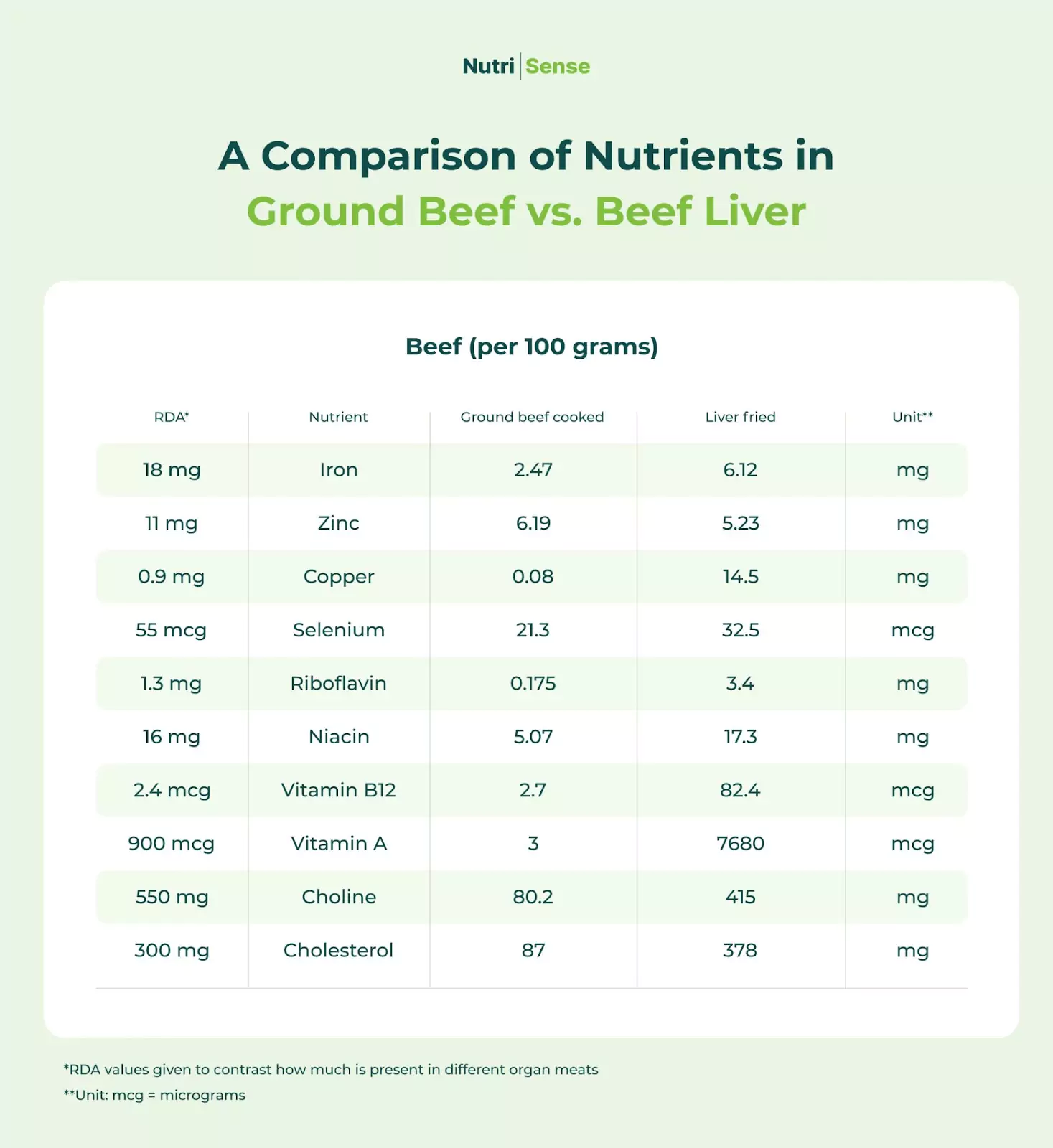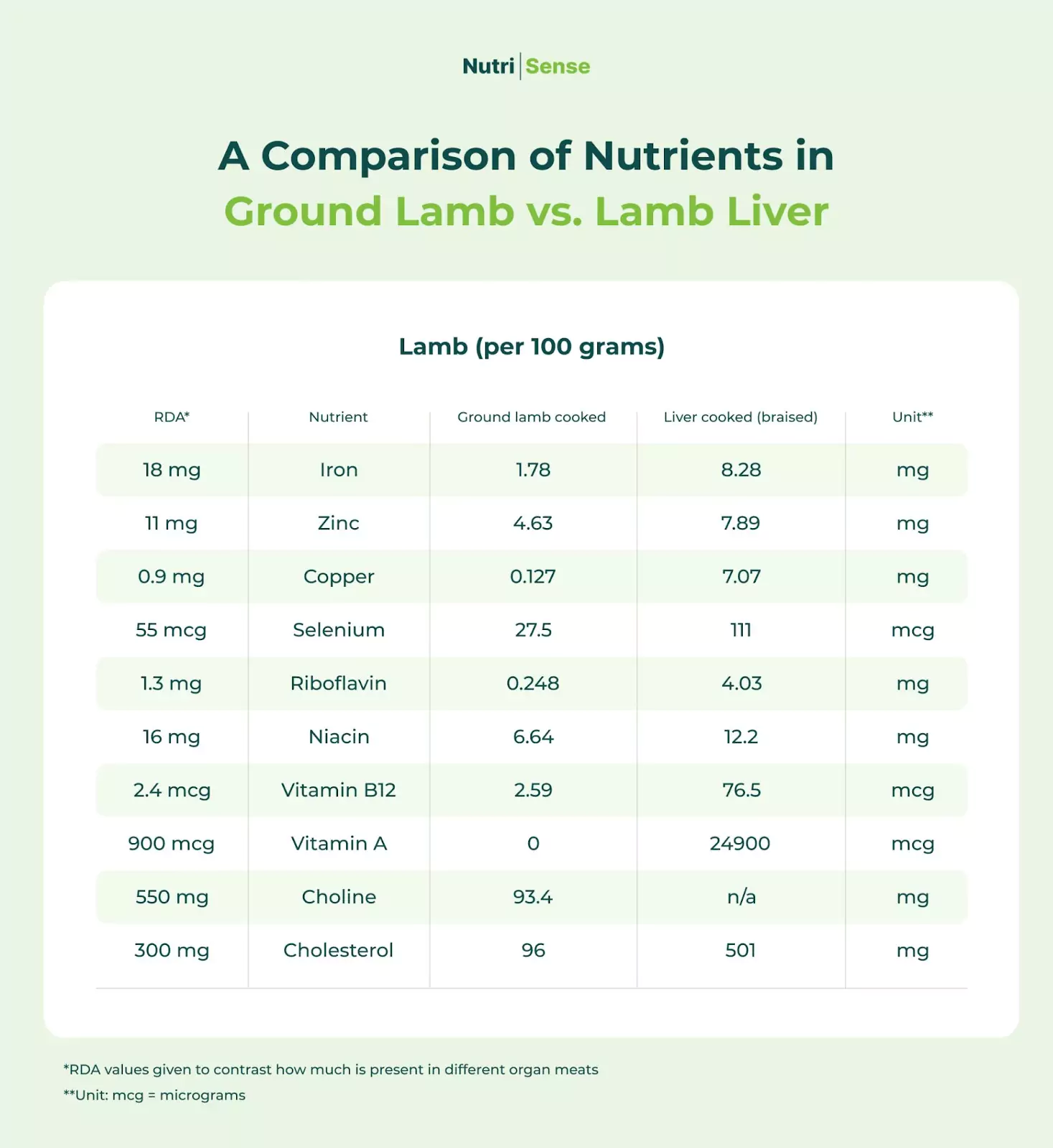Organ Meats: Should You Be Adding Them to Your Diet?

Key Takeways
When we think of chicken, beef, pork, or lamb, we generally picture a chunk of meat on our dinner plate from the breast, thigh, shoulder... But other parts of the animal are increasingly overlooked when it comes to nutrition.
Yes, we’re talking about animal organs like chicken liver, tripe, heart, and kidneys. It’s not as strange as it sounds. Chicken and pork liver are common ingredients in pate, and connective tissues like collagen and elastin are in many supplements and wellness drinks.
Organ meats were, and still are, widely eaten in some parts of the world. Yet the appeal of organ mean seems to have diminished drastically, especially where big, juicy cuts of muscle meat are relatively cheap.
Should you consider adding these parts of the animal to your diet? Read on to learn more about the health benefits of organ meats, read our handy nutritional content charts, and then scroll down for some great recipe recommendations.
What Constitutes Organ Meat?

As the name suggests, organ meats come from animals' internal organs or by-products. Sometimes referred to as offal or ‘variety meats,’ they include the heart, liver, kidney, and brain.
Other organ meats, such as the stomach, intestine (tripe), lungs, testicles, and pancreas, are less common but may also be nutrient powerhouses. While not part of a typical diet today, organ meats have been part of the human diet for centuries.
The Nutrient Content and Benefits of Organ Meats
Most organ meats are a good source of various nutrients and minerals, including essential amino acids, vitamin B12, magnesium, folic acid, and fat-soluble vitamins like vitamin D, K, and A.
They tend to be higher in some micronutrients than their traditional muscle meat counterparts, and are also rich in and are also rich in trace elements of iron and zinc. Many of these nutrients may help to support our immune system and overall energy levels. Keep in mind that because many parts of these animals constitute organ meat, there will be a variation in the nutrients provided, from one animal to the next.

You can learn more about the nutrients in organ meats and how to add them to your diet by working with a credentialed dietitian or nutritionist. In the meantime, here are 10 of the healthy nutrients that organ meats typically contain.
1) Protein
Organ meats are high in protein and low in carbohydrates, but not all contain as much protein per 100 grams as muscle meat does. Liver and heart have the highest proportion of protein among the organ meats.
2) Vitamin A
Vitamin A is required for your vision, immune system, and reproductive health, according to Mayo Clinic. It may even act as an antioxidant. Some organ meats are a storehouse of vitamin A, especially the liver. For instance, raw beef liver has over 9,000 micrograms of vitamin A, most of which is retained through the cooking process.
3) Riboflavin
Also known as vitamin B2, riboflavin is necessary for proper cell growth and function. According to the NIH, it also aids in energy production because it helps break down carbohydrates, proteins, and fats. Organ meats such as liver, heart, and kidney are rich in riboflavin.
4) Niacin
Another crucial nutrient in organ meat (especially heart, kidney, and liver), niacin also goes by the designation vitamin B3. It works in conjunction with various enzymes to help your body function well. The Harvard School of Public Health estimates that more than 400 enzymes are dependent on niacin for various chemical reactions.
5) Vitamin B12
One of the essential B-vitamins, vitamin B12 helps the body produce DNA during new cell production. The nutrient is abundant in organ meats and supports the healthy functioning of nerve cells, assists in forming red blood cells, and reduces the risk of macular degeneration. The liver is the most B12-dense of all offal, with almost ten times as much vitamin B12 as in the heart and kidney.
6) Iron
For those with anemia or an iron deficiency, organ meat can be a good source of iron, which helps make hemoglobin in your red blood cells. Iron also helps the muscles store oxygen, and it is involved in producing some hormones.
7) Zinc
Zinc is known for its role in wound healing and replenishing genetic material. It supplements the immune system in its fight against bacteria and viruses and benefits your sense of taste and smell. Organ meats have a healthy helping of zinc. For example, 100 grams of liver can give you about half your Recommended Dietary Allowance (RDA) of zinc.
8) Choline
Choline is a nutrient that can help keep your brain, liver, and muscles healthy and helps regulate your mood. Cooked beef liver, in particular, is a good source of choline. Some research suggests that high amounts of choline may increase the risk of cardiovascular disease, so consuming it in moderate amounts is a good idea.
9) Copper
Copper plays a role in brain health, protects the body from damage, and helps absorb iron. You need copper in trace amounts, and it’s found in abundance in organ meats. Except for liver, in which it far exceeds the recommended daily amount for adults, there is a healthy amount of it in organ meats.
10) Coenzyme Q10
Like fatty fish, organ meats also contain Coenzyme Q10 or Coq10. Your body also produces this essential nutrient, but production may decrease as you age. The fat-soluble nutrient helps your cells produce energy and may reduce the risk of cardiovascular disease.
Protein Content of Different Meats
The protein content in different types of meat, such as chicken, steak, and beef, and organ meats can vary depending on the specific cuts and preparation methods. So what has more protein, chicken or red meats?
Generally, chicken breast is considered a lean source of protein, with about 31 grams of protein per 3.5 ounces. When it comes to chicken vs. steak protein, cuts of steak like sirloin or tenderloin, can provide a similar or slightly higher protein content to chicken.
Beef encompasses various cuts of meat, with ground beef typically containing slightly less protein than lean cuts of steak. Overall, the specific cut and cooking method will determine the protein content, and it's advisable to choose lean cuts for a higher protein-to-fat ratio.
Nutritional Content by Animal
Are you wondering how much iron beef liver contains or what the vitamin A content of pork liver is? And are you also wondering if including these foods will help you meet your RDA for a specific nutrient?
Liver may be one of the most nutrient-dense organs. But how does it stack up against muscle meat? Here is a handy breakdown of the nutritional content in liver versus ground meat for beef, lamb, pork, and chicken!
Beef
You can pick from the liver, kidney, brain, heart, and lung when you eat beef offal. While our chart compares beef liver and ground beef, it’s also interesting to note that (cooked) beef brain is loaded with 3100 micrograms of cholesterol. That’s versus the 87 micrograms in ground beef.

Pork
You can pick from the liver, kidney, brain, heart, lung, and feet when you eat pork offal. Our chart compares pork liver and ground pork. But we’re sure you’re wondering about the feet—we were. Pig feet (trotters) have collagen and protein and are an excellent addition to soups, stews, and bone broth.

Lamb
Choose from the liver, kidney, brain, heart, lung, and tongue when eating lamb offal. The brain is pretty high in cholesterol but at 2040 micrograms, slightly lower than the cholesterol levels in beef brain. Check out the chart below to compare the nutritional content of lamb liver and ground lamb.

Chicken
The gizzards, liver, heart, and neck are the most commonly consumed chicken offal, although you can eat other parts like the brain too. Although not as low as ground chicken, the heart has the lowest cholesterol at 242 micrograms. Take a look at the nutritional content of chicken liver and ground chicken in the chart below.

Add our Five Favorite Organ Meats to Your Meals

Many things made with organ meat can be an acquired taste, like liverwurst and haggis. But organ meat is actually surprisingly easy to add to your diet.
You can add it into a soup or bone broth, make a pate or mix it into a ground beef dish like a shepherd's pie. But it’s also delicious as the main dish. If you’ve never eaten offal before, here are some of our favorites to help you get started:
1) Liver
Why add liver to your meals?
Apart from being rich in protein and low in carbohydrate content, liver is packed with iron and zinc and is a good source of vitamin A, folate, and vitamin B12. These contribute to a strong immune system.
Liver Recipe to Try
We love this quick meal of beef liver with bacon and caramelized onions from Barbara Bianchi at The Gluten Free Homestead. It even uses simple ingredients and calls for soaking the liver in milk to make it less bitter. You’ll need a pound of beef liver, half a cup of milk, three onions, four slices of bacon, five tablespoons of butter, and salt to taste.
2) Kidney
Why feast on kidney once in a while?
Kidney meat contains omega-3 fatty acids, which may protect against inflammation. Kidneys are also high in riboflavin (vitamin B2), contributing to healthy skin and brain function.
Kidney Recipe to Try
This French recipe for kidneys in mustard-butter and parsley sauce from Offally Good Cooking, adapted from one of Julia Child’s recipes, caught our eye. Don’t let the large portion sizes deter you; you can adjust the quantities depending on how many you are cooking for.
It uses two pounds of kidney (veal, lamb, or beef kidney), seven tablespoons of butter, one and a half cups of mustard, a small shallot, half a cup of dry white wine, a tablespoon of lemon juice, a quarter cup of parsley, and salt and pepper to taste.
3) Heart
Why put heart on the menu?
Because it is a good source of iron, zinc, and B-vitamins like vitamin B6 and B12, the heart is a powerhouse of nutrients. These nutrients are associated with healthy red blood cells and metabolic activity.
Heart Recipe to Try
This slow-cooked beef heart stew recipe from The Top Meal, which is low-carb, keto, and paleo, is one you should try. It takes about five to six hours to cook, but it leaves the meat soft and tender.
Cook it up with a pound of beef liver, a third of an onion, half a cup of water or beef broth, four cloves of garlic, and a teaspoon of salt. You’ll also need a crockpot to slow-cook the beef heart to tenderness.
4) Brain
What makes brain a good source of nutrition?
Like heart, brain is high in B-vitamins: niacin, riboflavin, and B12. If your diet lacks these essential nutrients, you can turn to animal brain to make up your requirement.
Brain Recipe to Try
The Recipes PK has a simple brain masala recipe that we love. It includes an extensive ingredient list, but it’s worth it! You’ll need four goat brains (you can substitute for lamb brain).
The recipe also has a three-quarter teaspoon of turmeric powder, half a cup of oil, one onion, two teaspoons of ginger-garlic paste, two tomatoes, seven green peppers (chilies), one teaspoon of crushed red pepper, one teaspoon each of cumin powder, coriander powder and garam masala powder, two teaspoons each of dry fenugreek and chopped ginger, and fresh coriander.
5) Tongue
What makes tongue such an excellent dish?
Apart from the fact that tongue is a good source of iron, zinc, and B-vitamins, its selling point is that it doesn’t taste as “meaty” or “organy” as other organ meats, making it an easy first step toward eating more offal. It can also be softer and more tender than other types of organ meat.
Tongue Recipe to Try
This beef tongue with mushroom and onion sauce recipe from Healthy Recipes results in tender meat that almost melts in the mouth. To make this dish that serves six, you’ll need two pounds of beef tongue, two bay leaves, and a teaspoon each of peppercorns and allspice.
The sauce requires two tablespoons of butter, eight ounces of mushrooms, two onions, two cups of beef or chicken broth, one teaspoon of salt, half a teaspoon of black pepper, and one teaspoon of cornstarch.
Risk Factors Associated with Eating Organ Meats
You now know that most organ meats provide many essential nutrients, but it is important to note that there are some risks associated with eating foods that contain very high amounts of some of these nutrients. For instance, did you know that brain contains high levels of cholesterol? A hundred-gram portion of cooked lamb brain, for example, has over 600 times the RDA for cholesterol. Here’s what you need to know before adding organ meats to your diet.
They Can Have High Metal Content
Organ meats are high in metals, particularly iron, zinc, copper, and selenium. While these are vital for your body, just 100 grams of some organ meats can have vastly more than the RDA for adults.
They May be High in Cholesterol
Some organ meats are much higher in cholesterol than muscle meats. According to the Encyclopedia of Meat Sciences by Ockerman and Basu, muscle meat contains 59 to 79 milligrams of cholesterol per 100 grams.
Heart, liver, and kidney can have as little as 130 milligrams and as much as 800 milligrams of cholesterol per 100 grams. And as we mentioned above, levels of cholesterol in brain are the highest—they can be more than 2,000 milligrams per 100 grams! For perspective, the RDA for cholesterol is 300 milligrams for adults.

There May be Links with Alzheimer’s Disease
Some research links meat and meat products like offal with oxidative stress. There is also some epidemiological evidence linking diet with the risk of Alzheimer's disease, according to a 2010 study appearing in the Archives of Neurology. It suggests that those who eat less organ meat—and more nuts, fish, poultry, and fruits and vegetables—have a lower risk of Alzheimer’s. But the link isn’t direct, and more research on the subject is necessary here.
Organ Meats and Blood Glucose
What effect do organ meats have on blood glucose? There isn’t much research specifically on how organ meats might influence blood sugar levels, but there have been studies on how certain meats like red meat might affect blood glucose.
A 2015 study published in The American Journal of Clinical Nutrition found that red meat intake was linked with higher fasting glucose and, at times, fasting insulin concentrations.
But, research is still ongoing if you’re looking for a link between things like liver, heart, kidney, and blood glucose. An excellent way to see how your blood glucose levels respond to foods like offal is to track and monitor your levels with a CGM.
The takeaway here is that unless you are watching your cholesterol or specific nutrient intakes, adding organ meats to your diet in a moderate way may be beneficial. They’re nutrient-dense, may benefit everything from heart disease to metabolic function, and are pretty delicious.
They’re also a good source for many trace elements that are hard to find elsewhere. But because of the large amounts and proportions of some of the same nutrients and minerals, a good approach may be to add organ meats to your diet as a portion of the meat you eat and not replace muscle meats with organ meats. It’s best to consult with your doctor or registered dietitian before adding or eliminating any foods, even nutrient-dense offal, to your diet.
A Note on Organ Complex Supplements
Organ meats have a strong flavor and odor and are sometimes an acquired taste. It may be why there are organ complex supplements on the market. Most of these claim to be made or contain nutrients from various organs of animals.
However, many don’t list nutritional information in a conventional way or have confusing nutritional facts labels. There isn’t enough scientific evidence on the benefits of organ complex supplements, and some believe you may be better off taking a regular multivitamin pill.
But as with anything, remember not to take any supplements without first consulting with a health professional.
Find the right Nutrisense programto turn insight into progress.
Go Beyond Glucose Data with Nutrisense
Your glucose can significantly impact how your body feels and functions. That’s why stable levels are an important factor in supporting overall wellbeing. But viewing glucose isn't enough. Nutrisense, you’ll be able to learn how to use your body's data to make informed lifestyle choices that support healthy living.
One-to-one coaching
Sign up to access insurance-covered video calls to work with a glucose expert: a personal registered dietitian or certified nutritionist who will help tailor your lifestyle and diet to your goals.
Monitor and measure what matters
With the Nutrisense CGM Program, you can monitor your glucose with health tech like glucose biosensors and continuous glucose monitor (CGM)s, and analyze the trends over time with the Nutrisense App. This will help you make the most informed choices about the foods you consume and their impact on your health.
Find your best fit
Ready to take the first step? Start with our quiz to find the right Nutrisense program to help you take control.

Natalie received her degree in Dietetics from Mansfield University and a Master’s in Clinical Nutrition from the University at Buffalo. Her career has included nutrition education and program development in her local community, adjunct faculty at several collegiate institutions, and clinical nutrition in both inpatient and outpatient settings.




